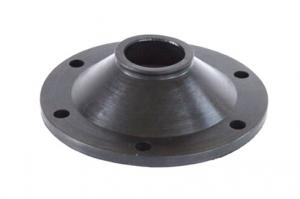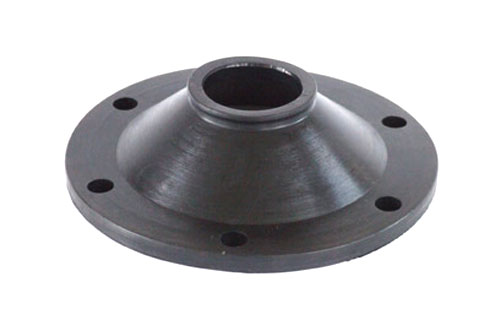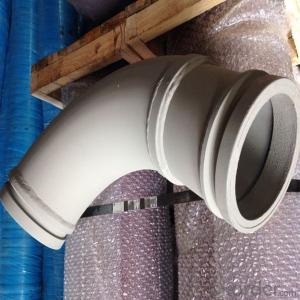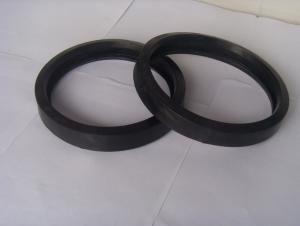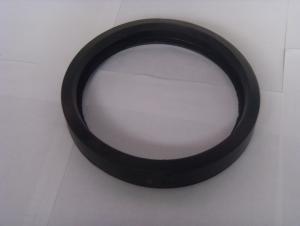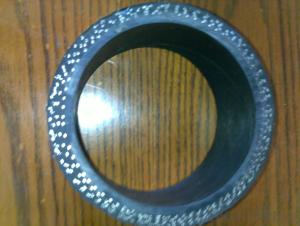Tapering Seal DN125 & DN150
- Loading Port:
- China Main Port
- Payment Terms:
- TT OR LC
- Min Order Qty:
- -
- Supply Capability:
- -
OKorder Service Pledge
OKorder Financial Service
You Might Also Like
Including: 1) Wear-resisting Board andCutting ink for Schwing, Putzmeister, Sany, Zoomlion, Kyokuto
2) Seal Ring/ Gasket for Schwing, Putzmeister, Sany
3) Schwing Kidney 10029138
4) Pipe Clean-out Accessories: Sponge ball, Sponge Column, Cleaningpiston
5) Conveying Cylinder for Schwing, Putzmeister
Products:
1) Rubber hose
2) Putzmeister/ Schwing/ Zoomlion/ SermacRam Pistons
3) Putzmeister/ IHI/ Kyokuto/ Zoomlion/Sany Seperated Piston
4) Wear-resisting board and Cuts ink
5) Coupling and seal ring for Putzmeister,Schwing, Sany
6) ST52 steel pipe, elbow, reducer
7) Cleaning seriesand others- Q: How often should concrete pump control panels be inspected and replaced?
- Concrete pump control panels should be inspected regularly, ideally on a monthly basis, to ensure they are functioning properly and to identify any potential issues. However, the frequency of replacement will depend on the specific condition of the control panel, as well as the manufacturer's recommendations. If any signs of wear or malfunction are detected during the inspection, it may be necessary to replace the control panel sooner.
- Q: How do I properly maintain and replace hydraulic cylinders in concrete pump spare parts?
- Proper maintenance and replacement of hydraulic cylinders in concrete pump spare parts requires a systematic approach. Firstly, regular inspections should be conducted to identify any signs of wear, leakage, or damage. It is important to clean the cylinders regularly to remove any debris or contaminants that can cause premature failure. To maintain the hydraulic cylinders, it is crucial to follow the manufacturer's recommendations for lubrication and fluid changes. Ensure that the hydraulic fluid levels are checked and maintained within the specified range. Additionally, monitor the pressure and temperature of the system to detect any abnormal conditions that may indicate a problem with the cylinders. When it comes to replacement, it is essential to use genuine and high-quality hydraulic cylinders that meet the specifications of the concrete pump. Consult the manufacturer's guidelines for the correct procedure for removing and installing the cylinders. Proper alignment and adjustment of the cylinders are crucial to ensure their optimal performance and longevity. In summary, proper maintenance involves regular inspections, cleaning, lubrication, and monitoring of the hydraulic system. Replacement should be done with genuine parts and following the manufacturer's guidelines. By following these steps, you can ensure the reliable and efficient operation of hydraulic cylinders in concrete pump spare parts.
- Q: How does a hopper agitator motor ensure consistent concrete mixing?
- Consistent concrete mixing is guaranteed with the use of a hopper agitator motor, which is responsible for providing the required agitation and movement within the hopper. By rotating and moving the agitator blades, the motor effectively mixes the concrete ingredients. The main purpose of the hopper agitator motor is to avoid the settling or separation of the concrete during the mixing process. Through its rotation, a swirling motion is generated inside the hopper, ensuring even distribution and thorough blending of all the ingredients. This prevents any formation of clumps or irregularities in the final concrete mixture. Moreover, the motor also aids in breaking up any lumps or clusters that may have formed within the hopper. This action further enhances the uniformity of the mixture, ensuring proper blending of components such as cement, aggregates, water, and additives. Furthermore, the continuous movement of the agitator blades helps in maintaining the desired consistency and homogeneity of the concrete mix. It prevents heavier particles from settling at the bottom of the hopper, ensuring consistent mixture throughout the entire mixing process. In conclusion, the hopper agitator motor is of utmost importance in achieving consistent concrete mixing. Its role includes providing necessary agitation, preventing segregation, breaking up lumps, and maintaining uniformity. The motor's rotational motion and well-designed agitator blades contribute to well-mixed and homogeneous concrete, which is crucial for durable and high-quality concrete structures.
- Q: How can one identify the correct part number for a specific concrete pump spare part?
- To find the appropriate part number for a specific spare part for your concrete pump, there are several steps you can take: 1. Refer to the equipment manual: Start by checking the manual that accompanies your concrete pump. It should contain a comprehensive list of parts, complete with their corresponding part numbers. This is the most reliable and accurate source of information. 2. Get in touch with the manufacturer: If you don't have access to the equipment manual or it doesn't provide the necessary details, reach out to the manufacturer directly. They should be able to help you identify the correct part number for the specific spare part you require. Provide them with as much information as possible, such as the concrete pump's make, model, and serial number. 3. Utilize online resources: There are various online platforms and parts catalogs available that offer detailed information about spare parts for different concrete pump brands and models. These resources often allow you to search for the part based on your concrete pump's make and model. However, make sure to cross-reference the information with the manufacturer's specifications to ensure accuracy. 4. Seek advice from a local dealer or distributor: If you're unable to find the correct part number through the aforementioned methods, consider contacting a local dealer or distributor specializing in concrete pump spare parts. They typically possess extensive knowledge and experience in identifying and sourcing the right parts for various equipment. Provide them with all the necessary details about your concrete pump, and they should be able to assist you in finding the correct part number. Remember, accuracy is crucial when determining the correct part number for a specific concrete pump spare part. Relying on trustworthy sources and consulting professionals will help guarantee that you obtain the appropriate part to meet your equipment's requirements.
- Q: How often should hopper grate levers be inspected or replaced in a concrete pump?
- Hopper grate levers in a concrete pump should be inspected regularly to ensure proper functioning and prevent potential issues. The frequency of inspections may vary depending on factors such as the intensity of use, the type of material being pumped, and the operating conditions. However, a general recommendation for inspections would be to perform them at least once every six months or after every 500 hours of operation. During the inspection, the hopper grate levers should be carefully examined for signs of wear, damage, or misalignment. If any issues are detected, the levers should be replaced immediately to avoid further damage to the hopper grate system or potential safety hazards. It is important to use high-quality replacement parts that are specifically designed for the concrete pump model in order to ensure optimal performance and longevity. Regular inspections and timely replacements of hopper grate levers will help to maintain the efficiency and reliability of the concrete pump, minimizing downtime and costly repairs.
- Q: How do I properly adjust and control flow rates in concrete pump spare parts?
- To properly adjust and control flow rates in concrete pump spare parts, you should start by examining the pump's manual and understanding its specific settings and controls. It's important to ensure that all valves and levers are in the correct position and functioning properly. Additionally, you can adjust the flow rate by manipulating the stroke length and speed of the pump. Experimenting with these settings while monitoring the flow rate will help you achieve the desired results. Regular maintenance and cleaning of the pump parts are also crucial to ensure smooth flow control.
- Q: How can a faulty pressure gauge affect the concrete pumping process?
- A faulty pressure gauge can have significant impact on the concrete pumping process. It can lead to inaccurate measurements of the pressure within the pump, which can result in improper monitoring and control of the pumping process. This can lead to over or under pressurization, affecting the flow and consistency of the concrete being pumped. Additionally, a faulty pressure gauge may not provide reliable readings, making it difficult to detect any potential issues or abnormalities in the pumping system, which can compromise the quality and integrity of the concrete being pumped.
- Q: What are the common issues that require replacement of concrete pump spare parts?
- Common issues that often require the replacement of concrete pump spare parts include wear and tear from continuous use, damage caused by debris or foreign objects in the concrete mix, corrosion due to exposure to harsh chemicals or weather conditions, and malfunctioning or worn-out components such as seals, valves, or pistons.
- Q: How often should hopper grate handles be inspected or replaced in a concrete pump?
- Hopper grate handles in a concrete pump should be inspected regularly for any signs of wear and tear or damage. The frequency of inspection and replacement may vary depending on the usage and condition of the equipment. It is recommended to inspect the hopper grate handles at least once a month or after every 500 hours of operation, whichever comes first. During the inspection, ensure that the handles are securely attached to the hopper grate and check for any cracks, bends, or other structural issues. If any damage is detected, it is advisable to replace the handles immediately to prevent any accidents or further damage to the equipment. It is also important to follow the manufacturer's guidelines and recommendations for maintenance and replacement of hopper grate handles. By regularly inspecting and replacing the handles as needed, you can ensure the safe and efficient operation of the concrete pump.
- Q: What are the common signs of wear and tear in a concrete pump cylinder?
- Some common signs of wear and tear in a concrete pump cylinder include: 1. Leaking oil or hydraulic fluid: If you notice oil or hydraulic fluid leaking from the cylinder, it is a clear sign of damage or wear. This can be caused by cracks, worn seals, or damaged gaskets. 2. Reduced pumping efficiency: A worn cylinder may result in decreased pumping efficiency, meaning the concrete pump may not be able to deliver the same amount of concrete as before. This can be due to a decrease in the cylinder's internal diameter or worn piston rings. 3. Increased noise and vibration: As the cylinder wears down, it may create more noise and vibration during operation. This can indicate misalignment, loose components, or damaged internal parts. 4. Rough or uneven concrete output: A worn cylinder can lead to a rough or uneven output of concrete. This can be caused by an irregular internal surface or damaged piston rings, affecting the smooth movement of the piston. 5. Excessive heat generation: If the concrete pump cylinder is worn, it may generate more heat during operation. This can be caused by increased friction between moving parts, which can further contribute to accelerated wear and tear. 6. Visible damage or corrosion: Inspecting the surface of the cylinder can reveal visible signs of wear and tear, such as scratches, dents, or corrosion. These damages can compromise the integrity of the cylinder and may require repair or replacement. It is important to regularly inspect the concrete pump cylinder and address any signs of wear and tear promptly to avoid further damage and ensure the pump's optimal performance.
Send your message to us
Tapering Seal DN125 & DN150
- Loading Port:
- China Main Port
- Payment Terms:
- TT OR LC
- Min Order Qty:
- -
- Supply Capability:
- -
OKorder Service Pledge
OKorder Financial Service
Similar products
Hot products
Hot Searches
Related keywords
